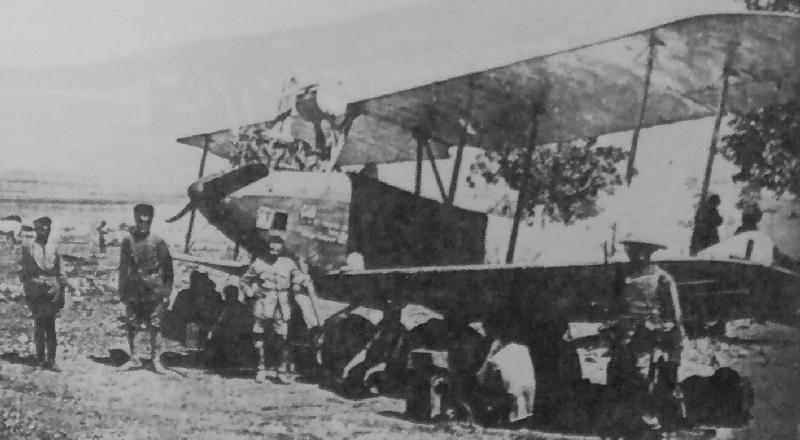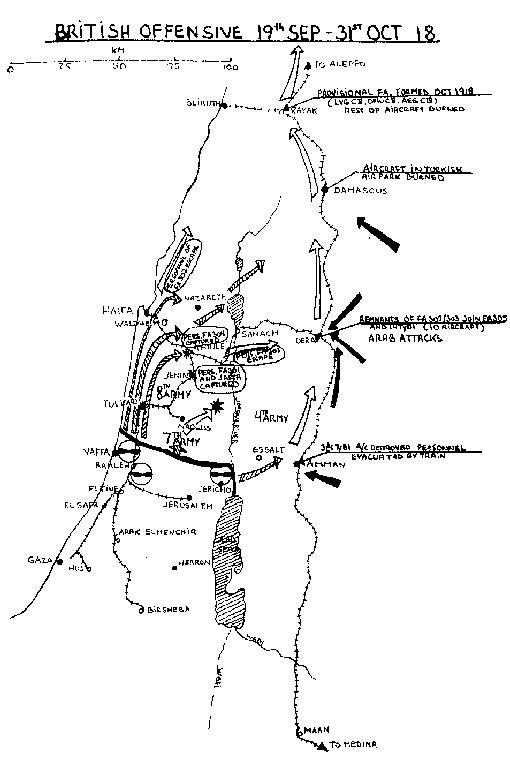Topic: Tk - Bks - Air Force
Pasha and Yildirim, the Palestine Front, 1915 to 1918

[From: Ole Nikolajsen, Ottoman Aviation 1911 - 1919, p. 210.]
Part 8 - The Final Destruction
The preparations for the final British breakthrough of the Turkish fronts in Palestine began with Arab attacks on the railway junction at Dera on 15 September 1918. This was a move to make the defenders believe that the main attack would come upon the widely dispersed 4th Army.
In order to secure the lines of supply and retreat for the whole front, on 16 September, 8 aircraft from Jenin were flown to Dera. This was a fortunate move as Jenin was attacked by two waves of enemy aircraft in the same afternoon. Two new aircraft however which just had arrived from Rayak were destroyed. During the whole day of 18 September, large formations of RAF aircraft prevented any German reconnaissance flights from being made. In the night, a Handley Page bomber dropped 2 tonnes of bombs on the Afuleh Junction, completely wrecking the important telephone and telegraph stations as well as the railway station and airfield. The Headquarters at Nazareth was thereby cut off from the front. The attack on the 4th Army was a feint and in the morning of 19 September, 3 cavalry divisions assisted by armoured cars first cut through the 8th Army, which was down to 8,000 fighting men and so hardly an army, in the coastal area and then swung towards Nablus in the south and Nazareth to the north.
Map of air activities covered by this extract
[From: Ole Nikolajsen, Ottoman Aviation 1911 - 1919, p. 194.]
[Click on map for larger version.]
The airfield at Afuleh was overrun and the personnel and 4 unserviceable aircraft of FA304(b) were captured together with the Commanding Officer Major Walz. The Major was particularly unfortunate in that he had just landed after a reconnaissance mission in an Albatros fighter. Almost at the same time, at Jenin, most of the personnel of FA301, under command of Captain Bieneck, was captured, together with 11 wrecked aircraft, 3 reconnaissance and 8 fighters of JASTA1. A major part of the personnel of FA303 and JASTA 1 had deployed to Dera on 15 September, but the ground crew under command of the Commanding Officer Capt. Steiner escaped north. FA302 under command of Captain König at Waldheim received sufficient warning to escape north along the coast in their Lorries. The two serviceable aircraft of the unit were both flown to Dera.
Already the next day, 20 September, the 8th Army had been [195] completely overrun. In order to avoid encirclement, on 21 September, the 7th Army began a withdrawal north in good order. Such was the power of the RAF squadrons that they were able to catch this army in Wadi el Fara and bomb and machine-gun almost all of its 10,000 men into destruction.
Meanwhile the remnants of the Pasha units in the 4th Army area had been taken under command of Captain Elias and operated as a single unit. At Dera, with 10 barely operational aircraft, it managed to keep Arab forces far enough away from the station and the railway line to save a large part of the fleeing troops, who were sent by train to Damascus. On 21 September, 2 DFW's were shot down, whereas 2 Pfalz fighters were forced to surrender when they ran out of ammunition. The next day one more DFW and one Pfalz were lost.
Most of the personnel of the Turkish units, 3ncü and 4ncü Tayyare Bölük were killed or captured when their evacuation train from Amman was attacked at Mafraq on 21 September and still more personnel of both 14ncü Tayyare Bölük and the German units were captured in a train outside Damascus on 30 September. Major Beltz, the KOFL, was taken prisoner after a forced landing outside Damascus.
Map of air activities covered by this extract
[From: Ole Nikolajsen, Ottoman Aviation 1911 - 1919, p. 196.]
[Click on map for larger version.]
A quick reorganization was affected at the Rayak Aircraft Park on 30 September and, despite the fact that many aircraft were serviceable, only 15 could be flown north to Homs due to shortage of aircrew. One AEG, 1 LVG and 4 DFW's being flyable were destroyed in addition to a score of aircraft in more or less derelict condition. Two DFW's were sent north to Iskenderun (Alexandretta) to cover the sea-flank against attacks and two reconnaissance flights were made over Cyprus. During the withdrawal two aircraft were lost between the 1st and 5th of October on flights from Homs. Between the 6th and 23rd October, another three were lost while operating from a field north of Aleppo near the railway junction at Mouslimiye.
At this time the front froze after newly formed Turkish units dug in near Islahiye where the terrain prevented the British from using their greater mobility. The Commander of this new front was Mustafa Kemal Pasha. When operating from a field near Islahiye between the 23rd and the armistice on the 30th, further two aircraft were destroyed by British bombing attacks and three in landing accidents on the rather unsuitable field.
Before this on the 12th of October a small force of Turkish mechanics had been ordered to the depot at Konya Aircraft Station in the middle of Anatolia to prepare aircraft for the front. Only 2 Albatros C.III's and 4 AEG C.IV's were found and prepared for flight but no pilots were at the station.
When the German Asian Corps under Command of General Liman von Sanders surrendered on 2 November at Adana only 600 aviation personnel including 20 officers were present out of an original force of 190 pilots and observers and 1400 other personnel which had been sent to Palestine since September 1917. Of the 155 aircraft delivered 3 were handed over to the 7 surviving Turkish pilots and observers and 8 mechanics the day before. They managed to escape to Konya and later formed the nucleus of the new air force of the independence forces in 1919.
Source: The above extract is obtained from a self published work by Ole Nikolajsen called Ottoman Aviation 1911 - 1919. The Final Destruction comes from Chapter 8, Pasha and Yildirim, the Palestine Front, 1915 to 1918, pp. 195-8. The text has been edited to remove errors and make it readable for an English speaking audience.
Further Reading:
Air War on the Palestine Front, December 1915 to January 1917
Turkish Units - The Ottoman Air Force
Lieutenant Colonel Hüseyin Hüsnü Emir, Yildirim
Go To:
Previous Chapter: The Pasha Units on the Southern Front





